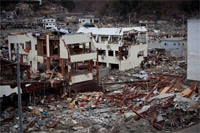



[TOKYO, Japan, 10 April 2011]
Today, the Japan Committee for UNICEF (JCU) and UNICEF Tokyo Office released the “Outlook on alternative care for children orphaned as a result of the Great East Japan Earthquake” (See Note 1), which is based on international treaties such as the Convention on the Rights of the Child and the legal frameworks of the Japanese Government.
 |
| © Japan Committee for UNICEF |
| Psychological assistance training provided at the UNICEF House in Tokyo. |
Tomorrow marks the one-month anniversary of the Great East Japan Earthquake, and the situation surrounding children that have lost their parents or guardians is gradually become clear. According to the Ministry of Health, Labour and Welfare, as of 8 April 44 children in Iwate Prefecture, 30 in Miyagi Prefecture and 8 in Fukushima Prefecture had been orphaned as a result of the earthquake disaster. Meanwhile, assistance focused on orphans is spreading throughout various areas.
Amidst this situation, it is vital to ask each child about his or her own feelings, properly assess the needs of each child, and then respond to the situation in a manner that serves the best interest of the child.
At present, JCU and the UNICEF Tokyo Office recommend prioritizing the following options in providing alternative care for orphaned children:
The options listed above place emphasis on connecting children with their existing friends and communities and are based on Article 20 of the Convention on the Rights of the Child (See Note 2), Concluding Observations of the Committee on the Rights of the Child (CRC/C/JAPAN/CO/3-52, 53, 54, 55) (See Note 3), Guidelines for the Alternative Care of Children (A/RES/64/142) (See Note 4), the Child Welfare Act (revised in 2008) (See Note 5) and the Ministry of Health, Labour and Welfare’s Guidelines on Foster Parenting (See Note 6).
We plan to utilize our knowledge of alternative assistance and child protection during times of disaster, and to continue cooperating with the Japanese Government, municipal governments, NPOs and other parts of civil society in expanding future assistance to children orphaned as a result of the disaster in order to develop environments that are friendlier to children.
Notes
| Receiving Prefecture |
Type of Emergency Supplies |
Arrival Date |
Quantity | Donating Company |
Comments |
|---|---|---|---|---|---|
| Miyagi | Water | 19 Mar. | 12,288 bottles |
VanaH Co., Ltd. | Two-liter plastic bottles |
| Fukushima | Water | 22 Mar. | 12,672 bottles |
VanaH Co., Ltd. | Two-liter plastic bottles |
| Miyagi | Underwear for boys and girls | 22 Mar. | 200,000 | ||
| Iwate | Underwear for boys and girls | 23 Mar. | 30,000 | ||
| Fukushima | Water | 23 Mar. | 4,680 bottles |
KIRIN MC DANONE WATERS Co., Ltd. | Two-liter plastic bottles |
| Miyagi | Children’s shoes | 23 Mar. | 10,000 pairs |
||
| Miyagi | RChildren’s diapers | 24 Mar. | 80 packs | P&G Japan | |
| Iwate | Children’s underwear | 24 Mar. | 9,700 | ||
| Fukushima | Water | 24 Mar. | 12,288 bottles |
VanaH Co., Ltd. | Two-liter plastic bottles |
| Iwate | Shoes | 26 Mar | 1,404 pairs | Achilles Corporation | |
| Iwate | Underwear for boys and girls | 27 Mar. | 28,266 | ||
| Iwate | Boots | 27 Mar. | 7,462 pairs | ||
| Iwate | Wipes | 28 Mar. | 1,200 | P&G Japan | For babies |
| Miyagi | Recreation kits Early Childhood Development kits |
2 Apr. | 50 of each | Procured from the UNICEF Supply Division | |
| Iwate | Recreation kits Early Childhood Development kits |
2 Apr. | 50 of each | Procured from the UNICEF Supply Division |
*In certain cases some supplies may be taken from prefectural supply storage warehouses and distributed to shelters and disaster sites in other prefectures.
As of 9:00 a.m. on 4 April 2011 (compiled by the Information and Public Affairs Division).